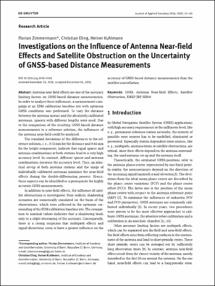Zimmermann, Florian; Eling, Christian; Kuhlmann, Heiner: Investigations on the Influence of Antenna Near-field Effects and Satellite Obstruction on the Uncertainty of GNSS-based Distance Measurements. In: Journal of Applied Geodesy. 10, 1, 53-60.
Online-Ausgabe in bonndoc: https://hdl.handle.net/20.500.11811/1442
Online-Ausgabe in bonndoc: https://hdl.handle.net/20.500.11811/1442
@article{handle:20.500.11811/1442,
author = {{Florian Zimmermann} and {Christian Eling} and {Heiner Kuhlmann}},
title = {Investigations on the Influence of Antenna Near-field Effects and Satellite Obstruction on the Uncertainty of GNSS-based Distance Measurements},
publisher = {de Gruyter},
year = 2016,
month = mar,
journal = {Journal of Applied Geodesy},
volume = 10,
number = 1,
pages = 53--60,
note = {Antenna near-field effects are one of the accuracy limiting factors on GNSS-based distance measurements. In order to analyse these influences, a measurement campaign at an EDM calibration baseline site with optimum GNSS conditions was performed. To vary the distance between the antenna mount and the absolutely calibrated antennas, spacers with different lengths were used. Due to the comparison of the resulting GNSS-based distance measurements to a reference solution, the influences of the antenna near-field could be analyzed. The standard deviations of the differences to the reference solution, i. e., 0.31 mm for the distance and 0.46 mm for the height component, indicate that equal spacer and antenna combinations at both stations lead to a very high accuracy level. In contrast, different spacer and antenna combinations decrease the accuracy level. Thus, an identical set-up at both antenna stations and the usage of individually calibrated antennas minimize the near-field effects during the double-differencing process. Hence, these aspects can be identified as a prerequisite for highly accurate GNSS-measurements. In addition to near-field effects, the influence of satellite obstructions is investigated. Four realistic shadowing scenarios are numerically simulated on the basis of the observations, which were collected in the optimum surrounding of the EDM calibration baseline site. The comparison to nominal values indicates that a shadowing leads only to a slight decreasing of the accuracy. Consequently, there is a strong suspicion that multipath effects and signal distortions seem to have a greater influence on the accuracy of GNSS-based distance measurements than the satellite constellation.},
url = {https://hdl.handle.net/20.500.11811/1442}
}
author = {{Florian Zimmermann} and {Christian Eling} and {Heiner Kuhlmann}},
title = {Investigations on the Influence of Antenna Near-field Effects and Satellite Obstruction on the Uncertainty of GNSS-based Distance Measurements},
publisher = {de Gruyter},
year = 2016,
month = mar,
journal = {Journal of Applied Geodesy},
volume = 10,
number = 1,
pages = 53--60,
note = {Antenna near-field effects are one of the accuracy limiting factors on GNSS-based distance measurements. In order to analyse these influences, a measurement campaign at an EDM calibration baseline site with optimum GNSS conditions was performed. To vary the distance between the antenna mount and the absolutely calibrated antennas, spacers with different lengths were used. Due to the comparison of the resulting GNSS-based distance measurements to a reference solution, the influences of the antenna near-field could be analyzed. The standard deviations of the differences to the reference solution, i. e., 0.31 mm for the distance and 0.46 mm for the height component, indicate that equal spacer and antenna combinations at both stations lead to a very high accuracy level. In contrast, different spacer and antenna combinations decrease the accuracy level. Thus, an identical set-up at both antenna stations and the usage of individually calibrated antennas minimize the near-field effects during the double-differencing process. Hence, these aspects can be identified as a prerequisite for highly accurate GNSS-measurements. In addition to near-field effects, the influence of satellite obstructions is investigated. Four realistic shadowing scenarios are numerically simulated on the basis of the observations, which were collected in the optimum surrounding of the EDM calibration baseline site. The comparison to nominal values indicates that a shadowing leads only to a slight decreasing of the accuracy. Consequently, there is a strong suspicion that multipath effects and signal distortions seem to have a greater influence on the accuracy of GNSS-based distance measurements than the satellite constellation.},
url = {https://hdl.handle.net/20.500.11811/1442}
}






